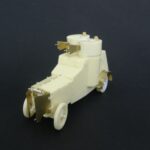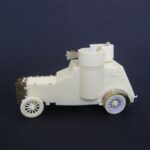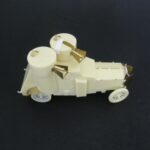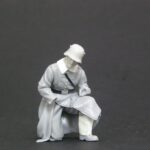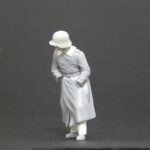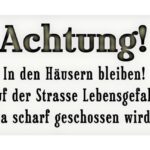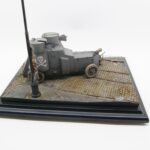The Fiat Izhorski history is here
This article was first published on September 4, 2016
The model is a model from Armo. This manufacturer is one of the few to propose models of the eastern countries during First World War. His catalog also contained an armored truck Putilov Garford, a Russian version Lanchester, an Austin Putilov and austin Kégresse. I had already mounted the ursus wz29 who also came from this manufacturer and even if there was some work needed, it was a model that is rarely seen on the tables. Izorski fiat (or izhorski or Izhora) is an interesting model because it is initially designed for the Russian army in World War I, also will be found captured in the Baltic countries and in Poland following the Polish-Soviet war of 1919-1921, and finally in the Freikorps in Germany. This is the version I chose to build in Berlin during the suppression of the Spartacist uprising of January 1919. The model is in a beige resin of goos quality without bubbles as often with Armo, casting shows no major defects except a shrinkage on the underbody that will be corrected by adding rivets. The instructions are not always easy to follow because everything is summed up in two drawings.
Improvements include:
– The left turret that is hollowed to allow the installation of the Maxim machine gun. The pivoting tappe allowed to fire up the buildings in the case of urban combat.
– The front part has been poorly understood by the manufacturer, the front of the frame must be remade and the lower triangular portion removed, the opening system of the front doors must be improved, a crank is added, Armo indicates wing nuts on the side walls of the engine but the photos confirm rivets, piano wire is added to the central hinges of the engine hood, the steering is remade with piano wire
– The connections of the rear fenders to the body are added.
– The rear wheels are improved.
– Some rivets are added with masterclub 5 mm.
The maxim machine guns come from the Aber 35L-164 kit for the A7V, they definitely bring more to the model
The scenery consists of a paved road portion with tram
Finally two Freikorps soldiers are added, they come from the dragon box 6190 frozen battleground, their uniforms should be reworked, the button is in one row, the neck is larger, the pants are worn long without the leggings as seen on pictures. Hornet heads are added. Currently soldiers are not completed
The model has been classically painted with a gray primer. For painting, I only use Tamiya, I find that they are very covering and easy to use, I first passed a layer of gray panzer lightened with white and a tip of blue, then re-lighted on top for a zenital effect, then varnish then decals then varnish again, then small touches with a small piece of foam then several wash, then lightening rivets and details then pigments. Nothing new, they are only techniques already used elsewhere.
The color is gray, it could be green, there is no precise reference. This vehicle was captured on the Russian army (like others) and then re-used by the Freikorps.
The main problem is decals. In the Armo box, there is no decals provided. On the market, finding skullheads on the 1/35 scale is complicated, moreover one can not print them oneself because they are white. Fortunately, a decals brand in the Netherlands helps to overcome this problem: blacklions decals.The bulk of their products are at 1/72 but on request they can provide the same decals at 1/35. Moreover, they have many rather exotic references. The final price is a bit expensive 16.5 € plus port but the quality is there and we have decorations for five vehicles.
The decor is an old resin reference that I duplicated in plaster with a miniart tram post. The posters and newspapers are taken on the internet and printed.







